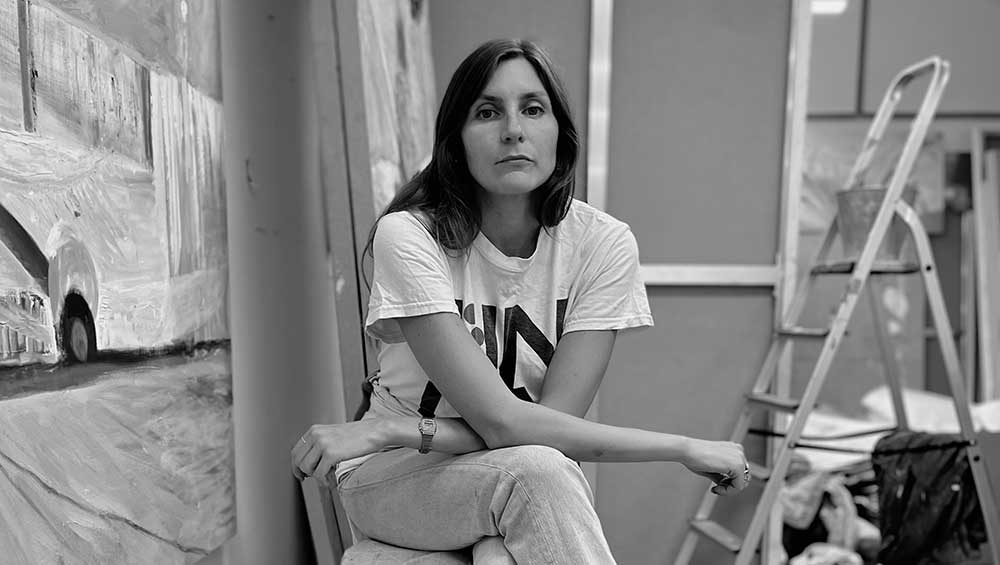
Gabriella Boyd. Courtesy of the Artist
by VERONICA SIMPSON
It is always a privilege to meet an artist in their own space – not only is it more revealing of their thoughts, inspirations and processes, but also the atmosphere in which they create. Gabriella Boyd (b1988) seems especially delighted to show me around her new studio in Bermondsey, south-east London. It is part of Drawing Room and Tannery Arts’ new Bermondsey complex, and she moved here when the building opened in September 2023. She is relishing the substantial, generously top-lit space, with north-facing windows that open, meaning she no longer has to inhale the scent of paint all day: there was a lack of ventilation in her previous, Woolwich-based studio. This room is at least 10m by 6m, with high ceilings, and walls filled with large and medium-sized, linen-bound frames in various stages of readiness. Along with the piles of books everywhere, and trays of paints, it summons a collage of intense interior exploration and contemplation as well as productivity and creativity.
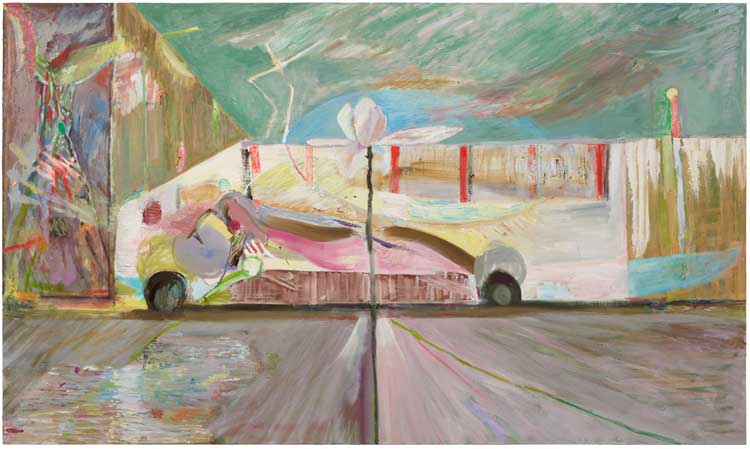
Gabriella Boyd. Guardians, 2024. Oil on linen, 125 x 210 cm. Photo: Peter Mallett.
Though born in Glasgow, Boyd moved to London with her family at the age of nine, returning to Glasgow School of Art at 18 to take her first art degree. Three years after graduating, she enrolled on the Royal Academy’s master’s programme, during which she began to win commissions, including one from The Folio Society for a set of haunting prints to accompany a new edition of Sigmund Freud’s The Interpretation of Dreams, published in 2015. In 2021, she was invited to participate in various group exhibitions including the Hayward Gallery’s Mixing It Up: Painting Today; The Garden at the Royal Academy, and Reconfigured at Timothy Taylor, London. Boyd was quickly signed to Grimm gallery and has had solo shows in its New York and London spaces, the latter in November 2023, followed by a solo spring/summer exhibition at Cample Line in the Scottish borders. Her US gallery, Micki Meng, is about to stage a major show at the unusual Espace Niemeyer – an organic, curving basement space whose undulating walls and top lighting should provide a stunning backdrop to the intense corporeality of Boyd’s paintings.
Studio International spoke with the artist in her Bermondsey studio in April and again in August 2024.
Veronica Simpson: Tell me about your early route to becoming an artist.
Gabriella Boyd: I studied painting and printmaking at Glasgow School of Art. At the time, my very young perspective was quite dated: I liked the idea of the “Glasgow Boys”, but I was thinking of 1980s painters. And then I found figurative painting was much less popular by then. Rightly so, there was a challenge – why paint? It wasn’t until I went to New York on an exchange from Glasgow that I thought, why not? You can just enjoy the painting side of it, in an unapologetic way and I found that really freeing.
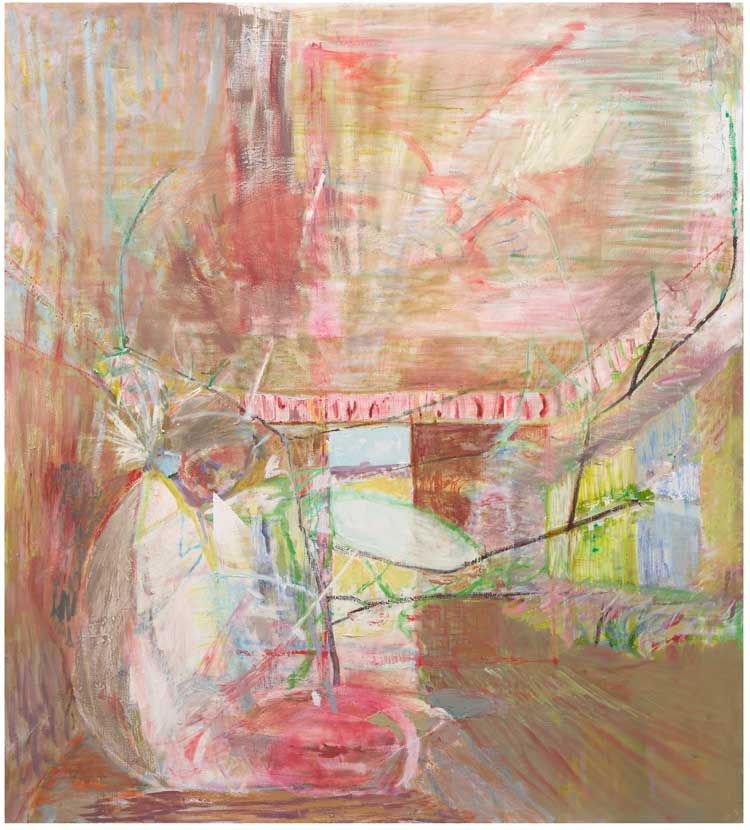
Gabriella Boyd. Scan, 2022-2024. Oil on linen, 200 x 180 cm. Photo: Peter Mallett.
VS: What were your first moves after graduating?
GB: I got a studio on my own in Peckham [south-east London]. I worked in a bar as well, but felt quite lonely in my practice – I had schoolfriends in London, but not a network of artists. And London seemed a bit impenetrable. So, after three years I applied to the Royal Academy because I felt I needed to have some conversations. And it was almost like three years of group therapy. It was very intimate. Being witness to other people’s way of making and understanding people’s practices through getting to know them was such an amazing thing.
After that, I absolutely wanted to make work that was unwitnessed – it was quite intense to make work in a space that’s on show. Luckily, some friends told me about the Woolwich space. Over the six years I was there, it was a good mixture of being a hermit when you needed to be, but also having people to share a cup of tea.
VS: There is so much intriguing layering in your pictures. I really enjoy that sense of internal and external landscapes blending. They feel very intimate, as if you are being drawn into whole emotional, physical and geographic worlds, but through snapshots, rather than detailed mapping. Your palette is also engaging, enticing. How does your work evolve?
GB: I think that the palette is really built through making works alongside each other. Often a body of work will share or be influenced by the multiple paintings made at the same time. And as for the layering of images, I like the idea of flitting between a diagrammatic idea – almost like a shorthand – of a room or a body part that we imagine, so the conflation of how we hold something in our minds and then mix that in with the experience of something from a bodily perspective or a visual sense. I like those two things informing each other. Sometimes, the work will have an anchor in it, to demarcate a space in the simplest way. There’s a motif that keeps cropping up of these sorts of creepers, like the wisteria plants you see attached to the fronts of houses. I might have a painting of that but fully on top of that I’ll paint figuratively. So, the creeper becomes bodily, almost like a network of nerves as well as an organic space. It’s almost like creating a language through visual elements. I’ve been making paintings of lightning bolts and they’re almost the same shape as these creepers, but they look like veins or a nervous system. There’s this flip between narrative and symbolism. So many of the paintings feel synthetic even though they are of bodies and landscapes.
.jpg)
Gabriella Boyd. Retina (Accordion city), 2024. Oil on linen, 180 x 210 cm. Photo: Peter Mallett.
VS: Where do you look for inspiration? There are lots of great books around your studio, novels, poetry and psychology books, such as the book on Freud that you illustrated. What was that experience like?
GB: I read the book and then chose sections of either Freud’s dreams or the client’s dreams. What was most interesting was the idea of translation: that it was originally the client translating their own dream to themselves and telling Freud and then Freud translating that back to them and him translating it into his book and me translating it back into images.
Is painting an attempt to translate our sensory experience of the world or like something that’s … outside of language? I find it the clearest form of communication: in that layering, you can get rid of the idea of a beginning and an end. I find that sprawling sense of space and layering close to how it feels to think and be in the world.
I think of the paintings as psychological spaces. That project was quite helpful in that it was such a specific task. It was a privilege. It’s such a beautiful thing to be part of. But it was also quite a constraint. I found myself having conversations with the editor on whether a bench should have slats or not – but we were talking about a dream! That liberated me to make paintings that weren’t even trying to describe anything. And I got into the idea of how far you could take that, the idea of making solid something that had no matter, whether it’s the space between two people or the atmosphere in a room. And I felt quite free after that to explore and be led by what was happening as I was making it.
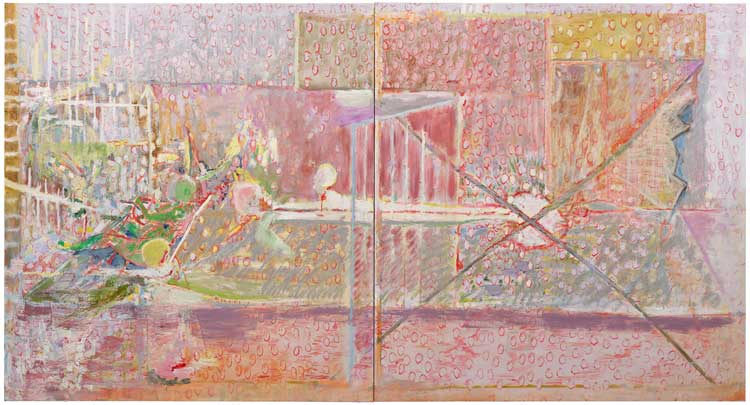
Gabriella Boyd. Floorplan, 2024. Oil on linen, 150 x 280 cm (diptych - each panel 150 x 140 cm). Photo: Peter Mallett.
VS: So, you developed a confidence in being more instinctive.
GB: Exactly. And, with writing, I’ve been drawn to writers who have almost compilation-style books, almost essayistic. Like Dept of Speculation by Jenny Ofill, where she is flitting between microscopic descriptions of the land on a cellular level or looking at space, and then going back to talking about a marriage that’s breaking down. And that buildup of how it feels to be conscious of the world on a zoomed-out scale and also your everyday life, without any prioritising of one over the other. To me that’s real intimacy – being placed in the head of another person. There’s an empathy that evokes your own feelings.
There’s a writer called Garth Greenwell, whose book Cleanness is an attempt to talk about desire and I listened to a beautiful interview he gave where he was talking about abstract thought being visceral and your physical or bodily experience being something that you analyse. And that resonates so well with me. That idea of sort of … wanting to charge a floor plan with emotion one day … a seemingly abstract, sterile thing.

Gabriella Boyd. Heart (iv), 2024. Oil on linen, 40 x 50 cm. Photo: Peter Mallett.
VS: Have you used floor plans in your paintings?
GB: There’s a painting called Heart. It was made last summer when my dad was really ill and none of the motifs were new to this painting but it’s when a particular personal context gives … a different energy and a narrative. And it just felt true. This painting just happened in the studio alongside my being in this state of family emergency. It felt like I was so conscious of how I was experiencing something that was hellish alarm and also pure love and how those two things can sit side by side. The floorplan being red like the body was a very crude bringing together of anatomy and architecture, and then there’s the fragility of the flowers drawn into the white. It’s an alarm and it’s also really peaceful. And these two things exist at the same time.
That was in my Grimm show (in London) and that was so intrinsic – this was the most important painting in the show.
VS: I wanted to talk to you about scale, and the way the worlds you present bring the viewer up close to a moment, and the people having that moment, while stepping back to show layers of scenery around them. There’s an intimacy, but also an immersive quality.
GB: Part of the reason I was drawn to painting was that experience of looking at a painting with your whole body. Not just optically. It’s hard to describe.
VS: The way you talk about expressing a bodily, a visceral, language in your painting, intrigues me. Have you developed this awareness through meditation or yoga practice?
GB: I would love to say yes. I have gone through phases of yoga and going back to yoga, but I wouldn’t say it’s an intrinsic part, though it is really the best sense of becoming conscious of your own body. I have always reached to it at a time when I need it the most and been really grateful for it, but then I like also knowing when to step back and let yourself be.
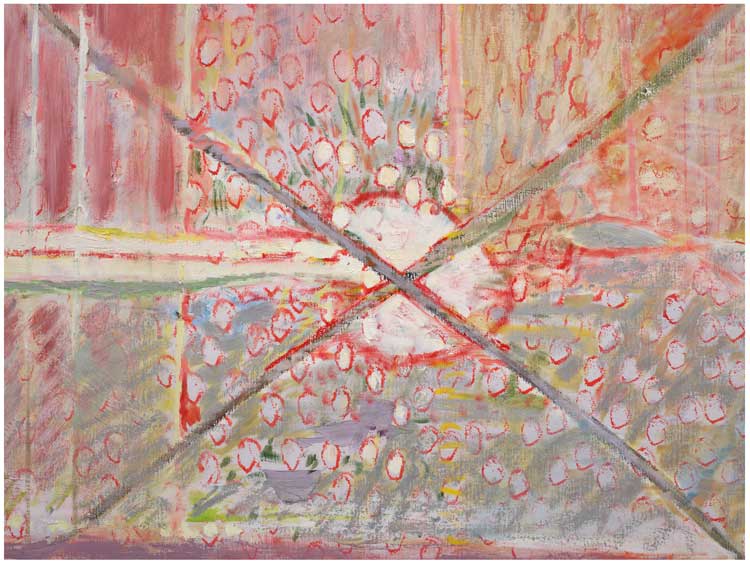
Gabriella Boyd. Floorplan, 2024 (detail). Oil on linen, 150 x 280 cm (diptych - each panel 150 x 140 cm). Photo: Peter Mallett.
VS: So, the way these feelings are articulated in your paintings is purely intuitive?
GB: So much of it is about reading the work, seeing what’s there so far and being true to it. Sometimes it takes a really long time before the work is doing something I want to follow.
VS: Is this (about 12) a typical number of canvases that you might have on the go?
GB: Yes, I think it allows me to be really free. It means I’m not too precious with anything. There will be things that are left out that can germinate the next body of work, which is always really helpful.
VS: How would you say your work is evolving in terms of themes and approaches? You have been busy with shows in the last year. Do you like working towards exhibition deadlines?
GB: It’s a good question. What I really like about (that) is it’s like a sort of resting point and a chance to hold together an atmosphere with that particular constellation of work; to see what I’m doing. Often, it’s not until the work is hanging and you see it in relation to other pieces that they take on a particular energy. The Grimm show in New York [November 2022], it is a huge space. The Grimm show in London was very different: it felt more intimate.
VS: And what about the new show in Paris? The Espace Niemeyer is an amazing interior to show your work in.
GB: The works here all started from a point before (we knew we had the space), and I think that’s useful. I find it helpful to make the works independent from the show or the gallery initially, because they’re about the conversation between each other. But a couple of months before the show, I’ll start thinking spatially about how the paintings will hang together.
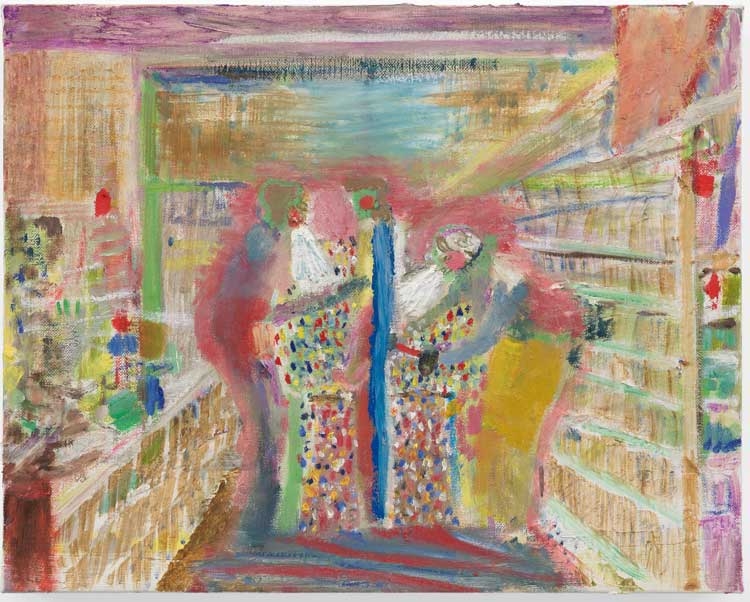
Gabriella Boyd. Harfleur Pharmacy, 2024. Oil on linen, 40 x 50 cm. Photo: Peter Mallett.
VS: There seems to be a lot of energy and movement in these works, compared with the ones I saw in the spring, which were for your Cample Line show, set in the countryside. There are sparks and lines flowing around and between people, which are more clearly articulated.
GB: Many of the paintings have this sort of thread running through them of these … visualisations of connection, whether it’s synapses or lightning, or me rendering energy somehow visible. And there’s also this visual association between the roots of trees and that being the same shape as the nervous system and that being the same shape as lightning, and the synapses of the brain and the interior of the body. There is a lot of light and white line, which is really an abbreviation, it’s not literal. There’s a sort of desire or a driving force in my work to somehow make the sensory experience into something tangible.
In my mind, when I’m working, it’s that idea of invisible energy and how it connects, not necessarily language or touch but just aura. I love that idea of trusting the power of that. I guess it’s a connection between the science and the physicality and our understanding of it.
VS: Have you been delving into the science side as well?
GB: My mum had a stroke about two years ago and she hasn’t been able to access language since. For the last few years, I have been learning a lot about what’s happening – how the left side of the brain affects the right side of the body. There was a really brilliant artist and scientist in the 1800s called Santiago Ramón y Cajal. He made these incredible drawings of the brain. They kind of look like roots, and they look like maps. They’re so beautiful. I was really held by the idea of medicine or illness turning your loved one’s body into a map.
My process is about working through intuitive and formal problems until I get to a believable emotional space. And it’s a way of me working out these new (emotional) territories that I’ve had to go through as well. It’s a real combination.
.jpg)
Gabriella Boyd. Lightning, 2024. Oil on linen, 80 x 55 cm. Photo: Peter Mallett.
VS: I love that notion of reaching a “believable emotional space”, because that is what they seem to be transmitting. Yet I am intrigued by how that can work differently for each person individually. We are all receiving your transmissions in our own way, depending on how we are feeling. For example, one thing that strikes me is the dominance of a lighter, whiter palette, with lots of pink and chartreuse in these new works. One of the reasons that resonates for me is, thanks to having eye surgery in both eyes earlier this summer, which was an extraordinary and near miraculous experience, that white light, tinged with pink and chartreuse, weirdly, was the experience that manifested in my vision while the surgery was in progress.
GB: It’s really interesting you say that, because I made a painting in 2020 called The Optician. It started off with this interest in a particular dynamic that’s formed in a medical context where you are cared for in a very structured way. But also the experience of having parts of your body drawn out – like blood taken. I have always been quite faint having blood taken, and I remember a doctor getting Lucozade out of his backpack and giving it to me. I was thinking about these moments of care as a motif: that doctor and patient structure, the power dynamic. That translated into a painting I made of The Optician. But my grandma went completely blind when I was 21. I was really close to her. But at the point she went blind, she started describing these scenes she could visualise, these situations she thought were outside the window, but they were in her mind. So that combination of not denying her reality but hearing her imagine it inspired my interest in the fact that painting is inspired by looking. You can’t help but be aware of your eyes being a player in that. I am very interested in Sargy Mann, a painter who went completely blind in his 60s and yet carried on painting. His son would put white tack on a canvas (as a guide) and lay out the colours he liked to use. He’d paint from his mind’s eye. It’s that sense of vision being an internal thing and an optical device.
You say the colours are like the ones you saw, but it’s so intuitive, the way I arrive at these palettes: it’s about surfaces and colours in relation to what’s there, and some of it is intentional and some of it I will sit back and look at what it needs. Or if I want to change the emotional temperature of it. But some of it is unthinking. I like to sit back after and say: that feels like a bruise, or a platelet. Or I might want it to look like skin or like the body. I hold my interest in the body more peripherally.
VS: I was struck by your use of the word “germinate”, earlier, to describe how paintings left in this space will start to suggest things. I am sure it is important that you give this kind of germination time. How do you square that with the pressure of exhibition deadlines?
GB: It’s a real muscle I’ve had to develop. I used to find it uncomfortable and anxiety-making, and there was a lot of … stress [around deadlines]. And I think through having good experiences and trusting myself more and adapting, I’ve learned to follow what’s there. It feels risky but it always leads to a more present way of being with the work. I think it’s about ultimately being more interested in that as an attitude, long term, as an artist. Even if one year that means something feels really raw and … almost unfinished, I’d rather be doing that as my practice, because that’s where the discovery and the germination happens. And the thing that’s exciting for me is when I find paintings that feel like they couldn’t be any other way but they’re also surprising. I can only do that by trusting this process.
• Gabriella Boyd is at Espace Niemeyer, Paris, from 15 to 22 October 2024, coinciding with Art Basel, Paris.
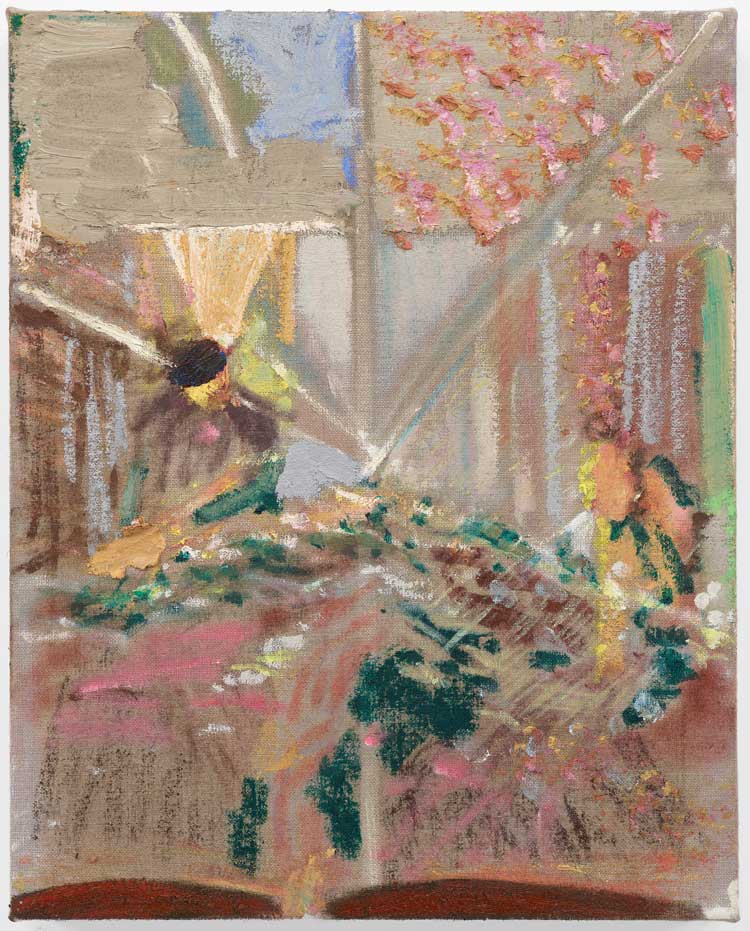
Gabriella Boyd. Stricture, 2024. Oil on linen, 50 x 40 cm. Photo: Peter Mallett.
Click on the pictures below to enlarge